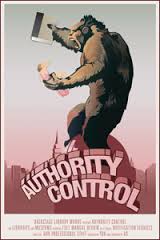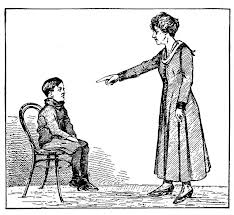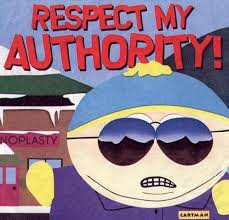“Authority is the thing I struggle with…I just don’t feel like I want to bully them into doing things..” Mike, Drama Teacher
 Questioning “Authority”
Questioning “Authority”
What does ‘Authority’ mean? Just because someone says you are in charge, does that mean you ARE in charge? Is authority useful? Do we need it? Is there good authority and bad authority?
In a recent CPD on Authority I was confronted by a teacher who said that authority was something to be mistrusted, that is was negative and should be avoided. In her mind authority was synonymous with abuse. Her reaction was very strong and very forthright, very authoritative in fact and we who were listening could feel her passion.
After a little questioning she revealed that she had been brought up in a country where the authority figures, e.g. the government, had been responsible for dreadful oppression and that her father was subject to that oppression. Her mistrust of authority, in the light of this experience was understandable.
Every time I have run sessions on authority, the beginning is often the same. There is a reluctance, a hesitancy in the room. It is as though I have posed a trick question. I think that one of the reasons for this is that we all have a personal experience of authority – we are all subject to imposed boundaries, some of which we accept and others of which we accept more reluctantly or reject. For our purposes as students scratching the surface of psychodynamics, it useful to reflect on the fact that we have had parents or carers who had authority over us, whose boundaries we had to adhere to before we knew better. Often, it is these models of authority that show up in us in our classrooms!
An Ambivalent Relationship
Strangely, teachers I have come across often have an ambivalent relationship with the concept of authority. I struggled for a long time to believe that my role in the classroom had anything to do with being an authority figure. It was the last thing I wanted to be. But that was because I had the wrong idea about what it meant to be an authority figure.
I was carrying beliefs about authority that had been formed before I could decide whether I agreed with them or not. But more of that later. Let’s start with a basic truth; like it or not:
- YOU are an authority figure.
- YOU have to be the initiator of ideas,
- YOU have to ‘take charge’.

What is Authority For?
- There are numerous theories about the place authority figures play within organisations and where they get their authority from. However, it is worth considering the straightforward question of what authority is for? Why do we need it? Or do we need it?
- In other recent sessions, responses to this question are varied. Some seem to think that civilisation needs authority to prevent anarchy. In other words, authority is to do with boundaries and the creation of order. This can be applied to organisations, like schools, or groups, like classrooms. Authority, in this instance is not sinister but a necessary way of making sure order is maintained so that something can be produced.
- Others have then mentioned authority figures for whom authority is an extension of their vanity. In these environments authority is synonymous with control, with protecting the authority figures self-esteem at all costs. This authority figure tends towards being authoritarian – only their opinions count, only their survival is important.
- So which are you or which one do you aspire to be?
- “Good” and “Bad” Authority
It is worth thinking about the difference between what we would consider traits of ‘good’ authority and traits of ‘bad’ authority. Again, in sessions when asked this question, participants come up with similar answers. The list under the ‘Good Authority’ figure reads:
“Empowers others, Honest, Knowledgeable, Inspiring, Authentic, Brave, Enabling, Has Moral Principles, Fallible, Wise, Calm, Enthusiastic, Empathetic…”
Not surprisingly the list under the ‘Bad Authority’ figure read differently:
“Power trip, Self-esteem, unaccountable, infallible, Punitive, Distant, Bureaucratic…”
A psychodynamic approach
We have learned that the principles behind a psychodynamic approach to classroom management asks us to look at the anxiety in the classroom, both our own and that of the pupils. What seems clear from the contrasting lists is that the second list, the bad authority figure is a figure that is being driven to a great extent by his or her anxieties. They are in a position where they are defending themselves, they are in an environment where they feel under attack and where they are responding, to a large extent, not to the reality of what is happening in the room but to a perception of what is happening in the room. Their actions, driven by a certainty that if they do not attack, they will be devoured could be understood under the lens of the ‘paranoid schizoid’ position. Their sole purpose is to stay safe and survive by projecting all of their feelings of fear and inadequacy onto those over whom they have ‘authority’. In contrast, the former list, could be seen as the behavior of a figure who is able to see the anxiety, accept their part in it, take responsibility for helping to set useful boundaries in order for productivity to take place.
In other words, this is not about different people, or qualities or personality, it is about different perspectives. Viewed this way, the good authority figure is, in fact, the easier position to occupy because it is what everyone wants.
Anthon Obholtzer
Anthon Obholtzer condenses psychodynamic theories or authority by dividing it into three basic categories
- Authority from above
- Authority from below
- Authority from within
Authority from above he says can be understood to stem from ones “role in a system”, where your authority is “exercised on its behalf”. He refers to this as a “system of delegation…with terms of office…and responsibilities”. In other words, our authority is bestowed upon us by a system, in the case of teachers, by the school ‘system’ and those who are ‘in charge’ of that system. Intrinsic within that is our qualification for that role which comes with experience plus the passing of exams etc.
Authority from below is as straight forward to understand but possibly more challenging to achieve. It is the authority or those one has governance over. In the case of teachers, this would be the pupils. No matter how much a head teacher or a school authority or society says that you have authority, if the pupils think otherwise then your qualifications are worthless. Every teacher who has ever taught knows that. The pupils need to give you authority if you are to be successful. We have spent time thinking about how they might be more willing to hand over authority to you and we won’t dwell on it here. Instead, I would like to focus on the third category, that of Authority from Within.
Obholtzer defines Authority from within thus:
“…authority from within individuals largely depends on the nature on their relationship with the figures in their internal world, in particular past authority figures…For example, an individual might be appointed to a position of authority yet be unable to exercise authority on account of an undermining…by inner world figures”.
Inner World Figures
Who are these ‘inner world figures’ and how can they ‘undermine’ our ideas of ourselves as authority figures? To understand this fully enough for it to be useful, we need to stop thinking of psychodynamic ideas in the abstract or as a set of academic ideas and step into thinking of ourselves and our own childhood experiences as part of our own psychological make up. Whenever I get to this session in school there is often a ‘shift’ in the room. By that I mean that there is a sense that we are about to do something risky in that we are about to really bring some of our inner world into the CPD. It has always proved to be a very fruitful session because of that and I would encourage you to take a step toward rather than away from putting yourself in the position of developing child and developed adult.
Your Inner World Figures – governed by forces that you did not elect.
The real question then is, not who are these internal figures but who are YOUR internal authority figures? Who are the people from your past who have influenced your ideas of what it means for YOU to be an authority figure. You may have never thought about this before or it might be familiar to you. Whichever is true, think now about the way you were introduced to authority and boundaries, about how you were ‘disciplined’ or encouraged about who was calm and who was shouting and when. Think about the good things you learned and the less useful things. Then think about yourself in the classroom, as a student. Who was the teacher you loved? Who was the teacher you hated or thought was useless? Then take the next step and think of yourself as a teacher. When you are the authority in the room, who are you emulating, who are you being? Whose voice is telling you you are doing it well and whose voice is telling you you are not doing it so well? Really think about it. Really look at it. It might be useful to write down your thoughts and ideas. Try not to judge what you write. It is only for you to see. It is for no one else.
The point here is that we are governed by forces that we have not decided to elect. We are influenced in our behaviors from a time before words, from a time we could not decide what to believe or who to trust. We were the terrified baby, the helpless infant, the trusting latency child, the confused and struggling adolescent and now we are the fallible teacher. If we are really to get the best from ourselves and enjoy our work, we may need to think more about the behaviors we have learned and where they come from and then we might need to decide which are still of use to us today and which we can now begin to discard.
Who shows up when you a being “a teacher”?
In the session I ask participants to talk about who it is that shows up in the classroom when they are ‘being a teacher’. More often than not, teachers talk about their fathers and/or their mothers. They say things like “My God, that’s exactly what my father used to say!” Once recognised I ask them to make a list. It’s just the beginning of a list really. On one side of the list I ask them to put down what they would keep and still listen to from their internal figures and on the other side I ask them to put what they would want to let go of. I suggest you try it. It is the beginning of true reflective teaching practice.
What kind of inner world figure do you want to be?
Finally, consider the internal figures the pupils already have and the ones they are developing and, if you should ever have such a privilege, what sort of internal figure you want to be for them and their future.


